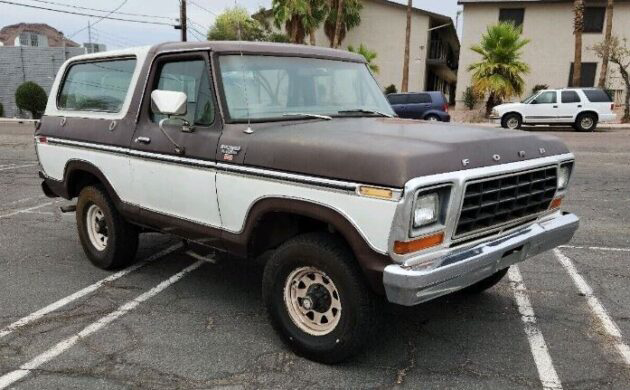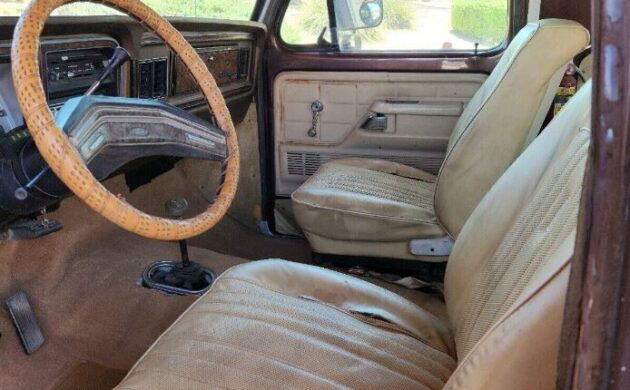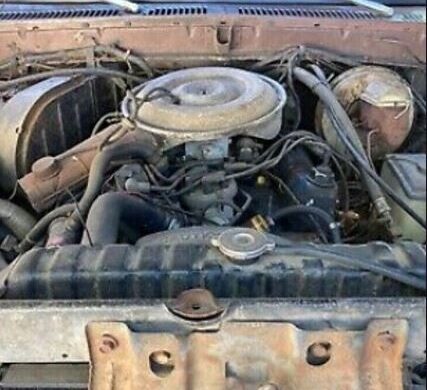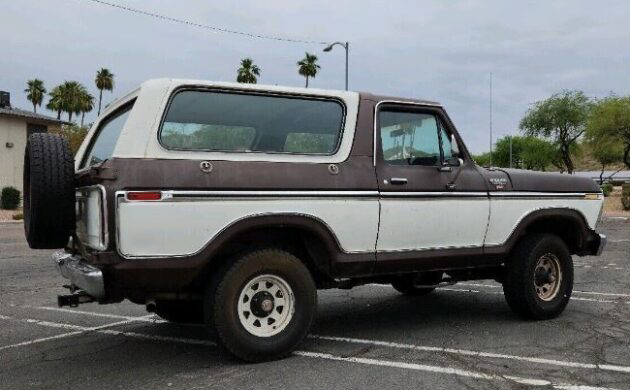Dry Climate Survivor: 1979 Ford Bronco XLT
Ford had a hit on its hand with its Second Generation Bronco. It only remained in production for two years, but total sales outstripped its predecessor’s best eight years combined. This 1979 Bronco XLT is a dry climate survivor with only minor panel rust. It runs and drives well, and its engine bay houses a healthy V8 with enough power and torque to tackle any obstacle. The first of these that it must clear is the road to a new home. It is listed here on eBay in Phoenix, Arizona. Bidding currently sits below the reserve at $7,100.
The seller confirms this Bronco spent its life in California before finding its way to its current location. Both areas have climates conducive to metal preservation, making this classic’s lack of significant rust unsurprising. The seller confirms a small area in the lower tailgate that is barely visible in the supplied photos. The remaining panels and lower extremities are clean, with the solitary underside shot revealing nothing beyond dry surface corrosion. The paint is so baked it is virtually impossible to determine the correct shades. However, it appears the original owner ordered this classic in a combination of Dark Cordovan and White. The vehicle would benefit from a fresh coat of paint, but the lack of rust means this could occur at the winning bidder’s leisure. The wheels could use a squirt of paint, but the trim and glass look surprisingly good for their age.
Vehicles of this type can feature interiors that have suffered with age, and this Bronco is no exception. However, it is not as bad as many we’ve seen at Barn Finds. The front seats would benefit from new covers, but the back seat looks pretty respectable. The carpet isn’t too bad, and the dash and pad look clean and free from UV damage. The door trims are aged, and the faux woodgrain is beginning to show signs of slight deterioration. I would class the interior as serviceable, and how much the new owner spends will depend on their desire for perfection. A Sony CD player occupies the factory radio’s rightful spot, while the original owner ordered this Bronco with air conditioning and cruise control.
Powering this Bronco is the 402ci “Ford 400” V8. The remaining drivetrain components are standard Bronco fare, including a three-speed automatic transmission, a dual-range transfer case, and power assistance for the steering and brakes. The engine produces 156hp and 277 ft/lbs of torque. Some readers might be surprised by how close those figures are to the entry-level 351M. That motor places 158hp and 262 ft/lbs of torque at the driver’s disposal. The power and torque delivery is almost identical between the pair, with nothing to separate them in either top speed or the ¼-mile ET. The seller recently replaced this Bronco’s brakes, with the listing suggesting it is mechanically sound. They describe the engine as strong, and the embedded video in their listing seems to support their claim. That V8 fires at the first turn of the key and sounds sweet and smooth.
Ford sold 104,038 Broncos during 1979, which must have resulted in some smiling faces in Detroit. The best its predecessor could achieve was 25,824 vehicles in 1974. The Second Generation remained in production for a mere two years before being replaced by a lighter and more efficient Third Generation. This vehicle shows promise as a project, mainly because its lack of rust and mechanical good health will allow its new owner to plan their approach without rushing. It has only attracted three bids, and I expected more interest. However, these auctions sometimes don’t kick into gear until the end is in sight, and that may be the case here. Are you tempted to pursue this Ford further? Please let us know if you do and are the winning bidder. I’m sure our readers would enjoy following your restoration journey. Good Luck.
Auctions Ending Soon
 1971 Ford Mustang Mach 1Bid Now14 hours$7,100
1971 Ford Mustang Mach 1Bid Now14 hours$7,100
 2003 Porsche Boxster SBid Now15 hours$6,250
2003 Porsche Boxster SBid Now15 hours$6,250
 1966 Lincoln ContinentalBid Now17 hours$500
1966 Lincoln ContinentalBid Now17 hours$500
 2000 Jaguar XJ8LBid Now4 days$1,250
2000 Jaguar XJ8LBid Now4 days$1,250
 1977 Datsun 280ZBid Now5 days$275
1977 Datsun 280ZBid Now5 days$275






Comments
Cool truck. My shop manager at Firestone back in 85 had a all black 79 351 m 400 with a 4 speed.Glwts.
A 51 cubic inch increase and zero extra power to go along with it. Did they use a smaller cam or more restrictive intake or exhaust on the 400?
A main reason they were slugs. They had every conceivable emmission control available at the time. The main culprit was the centrifugal advance did not start to advance until after 2000 RPM or higher. Most engines that respond nicely, the centifugal is done by 2000 RPM.